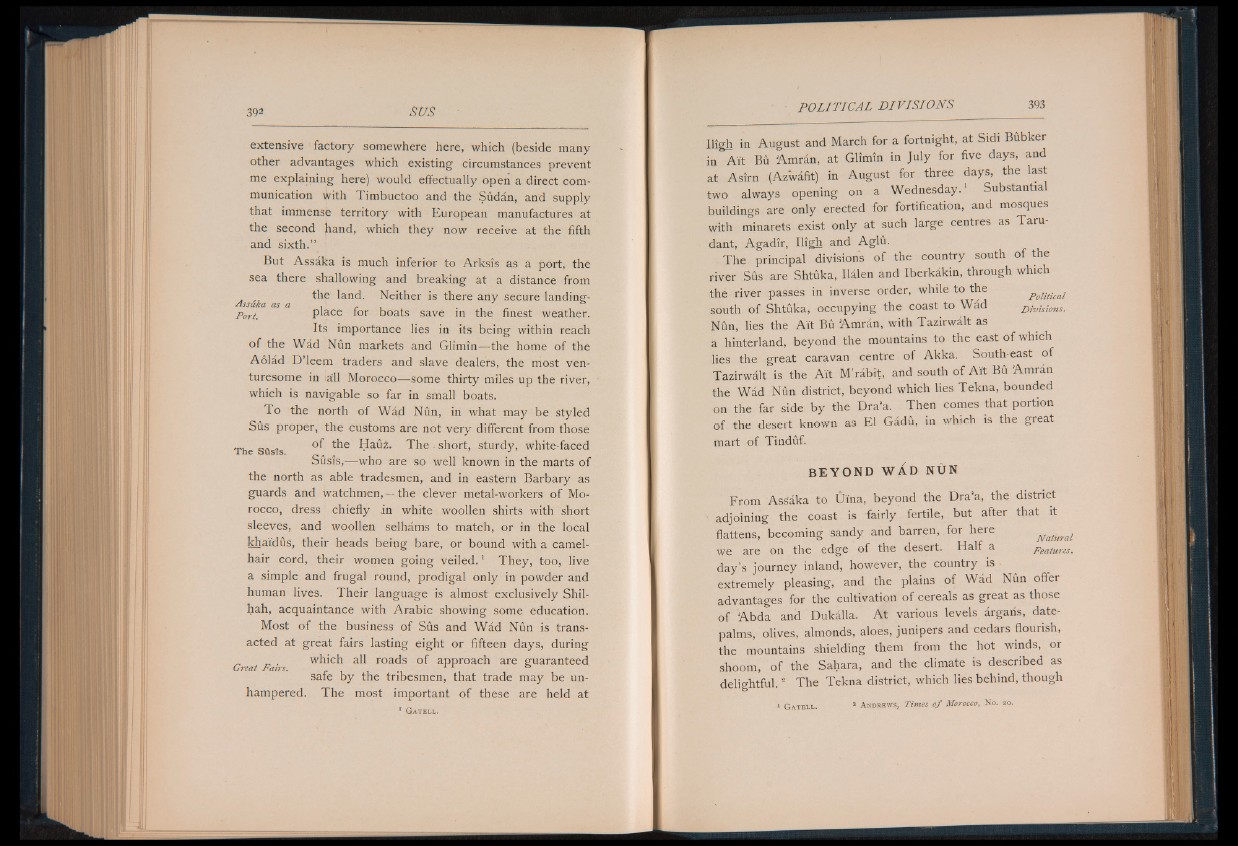
extensive factory somewhere here, which (beside many
other advantages which existing circumstances prevent
me explaining here) would effectually open a direct communication
with Timbuctoo and the Sudan, and supply
that immense territory with European manufactures at
the second hand, which they now receive at the fifth
and sixth.”
But Assaka is much inferior to Arksis as a port, the
sea there shallowing and breaking at a distance from
. ,, the land. Neither is there any secure landing-
Assaka as a . c .
port' place lor boats save in the finest weather.
Its importance lies in its being within reach
of the Wad Nun markets and Glimin— the home of the
Aolad D ’leem traders and slave dealers, the most venturesome
in all Morocco—-some thirty miles up the river,
which is navigable so far in small boats.
To the north of Wa.(d Nun, in what may be styled
Sus proper, the customs are not very different from those
The stisl ° f ^ e Haut. The : short, sturdy, white-faced
Susis,— who are so well known in the marts of
the north as able tradesmen, and in eastern Barbary as
guards and watchmen,— the clever metal-workers of Morocco,
dress chiefly in white woollen shirts with short
sleeves, and woollen selhams to match, or in the local
khai'dus, their heads being bare, or bound with a camel-
hair cord, their women going veiled.1 They, too, live
a simple and frugal round, prodigal only in powder and
human lives. Their language is almost exclusively Shil-
hah, acquaintance with Arabic showing some education.
Most of the business of Sus and Wad Nun is transacted
at great fairs lasting eight or fifteen days, during
. which all roads of approach are guaranteed
Great Fairs. o
safe by the tribesmen, that trade may be un-
hampered. The most important of these are held at
r G a t e l l .
Iligh in August and March for a fortnight, at Sidi Bubker
in A it Bu Amran, at Glimin in July for five days, and
at Asirn (Azwafit) in August for three days, the last
two always opening on a Wednesday.1 Substantia
buildings are only erected for fortification, and mosques
with minarets exist only at such large centres as Taru-
dant, Agadir, Iligh and Aglu.
The principal divisions of the country south of the
river Sus are Shtuka, Ilalen and Iberkakin, through which
the river passes in inverse order, while to the p 0utical
south of Shtuka, occupying the coast to Wad Divisions.
Nun, lies the Ait Bu Amran, with Tazirwalt as
a hinterland, beyond the mountains to the east of which
lies the great caravan centre of Akka. South-east of
Tazirwalt is the Ait M’rabit, and south of Ait Bu Amran
the Wad Nun district, beyond which lies Tekna, bounded
on the far side by the Dra‘a. Then comes that portion
of the desert known as El Gadu, in which is the great
mart of Tinduf.
BEYOND WAD NUN
From Assfaka to Ui'na, beyond the Dra‘a, the district
adjoining the coast is fairly fertile, but after that it
flattens, becoming sandy and barren, for here Natural
we are on the edge of the desert. Half a Features.
day’s journey inland, however, the country is ■
extremely pleasing, and the plains of Wad Nun offer
advantages for the cultivation of cereals as great as those
of Abda and Dukalla. A t various levels argaris, date-
palms, olives, almonds, aloes, junipers and cedars flourish,
the mountains shielding them from the hot winds, or
shoom, of the Sahara, and the climate is described as
delightful.2 The Tekna district, which lies behind, though